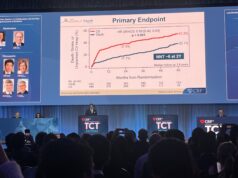
The largest study to date of the role of frailty indices after transcatheter aortic valve implantation (TAVI) has demonstrated that the markers of low albumin, anaemia, and slow walking speed are significant independent predictors of mortality and morbidity in patients undergoing TAVI. Researchers Soroosh Kiani (Emory University School of Medicine, Atlanta, USA) and colleagues recommend that their existence should raise concerns about the likelihood of frailty and prompt further investigation.
Writing in JACC: Cardiovascular Interventions, the authors point out that the indices are simple, easily attainable and clinical relevant markers of frailty that may meaningfully stratify patients at risk for mortality after TAVI, “further facilitating robust modelling and adjusting for a large number of confounders”.
The study sought to evaluate the ability of individual markers of frailty to predict outcomes after TAVI and of their discriminatory value in different age groups. Kiani et al assessed patients ≥65 years in the Society of Thoracic Surgeons/American College of Cardiology Transcatheter Valve Therapy registry, linked to Centers for Medicare and Medicaid administrative claims data, who received elective TAVI between November 2011 and June 2016 (n=36,242). Indices of frailty included anaemia, albumin level, and five-minute walk speed. Cox proportional hazards regression was performed for 30-day and one-year mortality, adjusting for risk factors known to be predictive of 30-day mortality in the Transcatheter Valve Therapy registry, as well as survival analysis.
The researchers found that the three indices are independently associated with mortality at 30 days and one year; among the tested makers of frailty, low albumin was most associated with mortality at 30 days (adjusted hazard ratio (HR) 1.3, 95% confidence interval (CI) 1.1–1.5, p<0.001) and one year (adjusted HR 1.5, 95% CI 1.4–1.6, p<0.001). In addition, those with anaemia, after controlling for albumin status, remained at increased risk of mortality at one year (adjusted HR 1.2, 95% C: 1.1–1.3, p<0.001). And, those with slower walking speeds remained at a high risk for the primary outcome at one year after adjusting for albumin and anaemia status (adjusted HR: 1.4, 95% CI 1.2–1.5, p<0.001). The investigators also noted that the indices provide incremental value in risk stratification for mortality, with low albumin providing the largest value (HR 1.52). Those with low albumin and slower walking speed had longer lengths of stay and higher rates of bleeding and readmission (p<0.001). Those with anaemia also had higher rates of bleeding, readmission, and subsequent myocardial infarction (p<0.001).
The authors advise that patients with positive indices of frailty should be counselled about their increased risk for poorer outcomes after TAVI, although they caution that it “remains to be seen” whether or not modifying these risk factors will impact outcomes. Describing it as an area of potential future investigation, they write: “Further studies need to explore whether modification of these markers of frailty can reduce the risk of mortality after TAVI, or whether they only serve as indirect markers of more profound clinical impairment.”
An accompanying comment piece by Christopher Allen (St Thomas’ Hospital, King’s College London, London, UK) described the findings as a “further important step forward in our ability to accurately identify frailty and its relevance to outcome in patients undergoing TAVI assessment”. However, he pointed out: “The most pressing question remains: once frailty is diagnosed, what do we do about it?”













